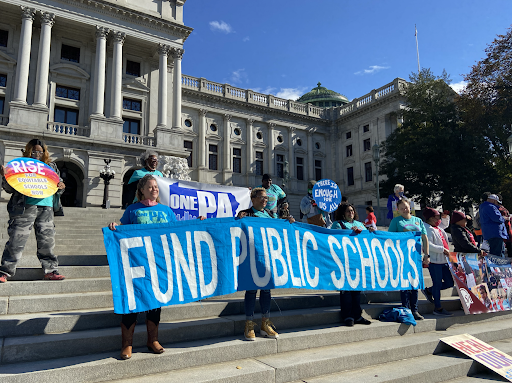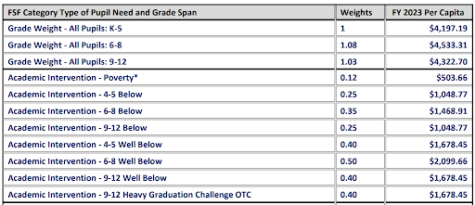Earthquake: The Ruling That’s Shaking PA’s Public School Funding

March 28, 2023
On February 7, 2023, the grounds of the Commonwealth Court in Harrisburg shook in a historic triumph for low-income school districts. Pennsylvania judge Renée Cohn Jubelirer ruled that the public school funding system fails to meet the obligations outlined in the State Constitution. Citing The Education Clause (article III, section 14), which maintains public schools’ duty to ensure significant access to education, Jubelirer found that the funding structure, which favors districts of high property and income value, falls short of this standard. Lauded as an “earthquake that will reverberate… for a long, long, long time,” the decision catalyzed discussion around future steps for the PA Department of Education.
The ruling sided with a collection of six lower-income districts and select organizations that, since 2014, have fought for an equitable examination of district funding. According to the Court, not only does the Pennsylvania Constitution recognize education as fundamental to the livelihood of school-aged children, but it demands that students are not discriminated against in the pursuit of such opportunities – this extends to discrimination on the basis of income level and taxable property value. The Department of Education’s oversight has contributed to a history of power imbalances and disparities between districts.
This story could be told with one glance around Radnor’s library. On either side, current books of every genre line the shelves. Student voices echo among the sounds of people typing on their district provided devices and the smooth sliding of cushioned swivel chairs. Databases with dizzying amounts of resources are available with one request. Large windows reveal a sprawling campus, and the noises of multi-million dollar renovations float in the background. With one 20 minute drive to William Penn School District, however, the story takes a turn. In just 12.3 miles, the luxuries of Radnor’s construction projects and course offerings fade into outdated facilities and limited options. In 54.9 miles, to McCaskey High School in the School District of Lancaster, the opportunities similarly change. And in 228 miles, to the Greater Johnstown School District, the same story is told.
William Penn School District, the School District of Lancaster, and the Greater Johnstown School District (GJSD) are all listed as petitioners in the case, William Penn School District, et al. v. Pennsylvania Department of Education, et al. Each noted their individual grievances, but one common thread emerged: despite extraordinary efforts to inwardly remedy the funding deficit, the districts find themselves in a perpetual state of economic crisis. William Penn School District, for example, ranks as the 66th poorest school district in the commonwealth, according to the Market Value-Personal Income Aid Ratio. Moreover, whereas Radnor’s wealth of opportunities is available to just under 3,600 students, the School District of Lancaster, which includes both the City of Lancaster and Lancaster Township, must provide for more than 11,000 students. Teachers from GJSD referenced not only limited educational resources, but facility deprivations, including a first-grade wing with only one bathroom shared among 125 students.
Both Greater Johnstown and William Penn School District drew attention to the “general fund,” the single source of funds available to districts in Pennsylvania. Districts’ budgets are defined by the difference between assets and liabilities. Within the “general fund,” districts manage a variety of balances, including non-spendable funds, restricted funds, committed funds, assigned funds, and unassigned funds. The fund balance is often utilized as an immediate source of payment, especially by poorer districts. When a district is awaiting receivables, or payments that are designated but not received, it can use the fund to pay employees or finance repairs. The fund is also used during delays to the Commonwealth’s budget enactment. If the balance runs out, districts are forced to borrow money through tax anticipation loans, which collect interest. This compounding debt leads to restricted opportunities and poor student performances.
Without being able to justify this inequality, the Department of Education must now reevaluate its system, a process that will take patience and time. Because Pennsylvania’s Republican lawmakers will not appeal the decision, it will move to the legislature. Simply redistributing the money will do little to solve the systematic disparity. As such, many experts have looked to other states that previously reformed their funding structures, including New York.
In 1993, the New York nonprofit Campaign for Fiscal Equity (CFE) launched a lawsuit against the state, claiming, as did the petitioners in Pennsylvania, that the public school funding system was unconstitutional. In 2001, the NY Supreme Court sided with CFE, but the state refused to comply with the orders. After a series of appeals, the legislature agreed to develop a new funding formula, called the Fair Student Funding Formula (FSF), but the recession of the following year made budget cuts unavoidable. In April of 2021, New York Mayor DeBlasio announced that all public schools would receive full funding in accordance with FSF. COVID-19 again devastated the public system, and the new Mayor, Eric Adams, announced FSF cuts of $215 million. Parents increasingly called for the use of unspent federal stimulus funds for FSF.
The FSF allocations are weighted based on the needs of a district. All schools receive a foundation allocation of $225,000. This number is expanded upon using a formula that accounts for the student needs at a given district valued at the cost of providing them. There are three categories of student need, including those for academic intervention, English language learners, and students enrolled in special education programs. The following is the academic intervention portion of this weighting system taken from the 2023 FSF Guide:

Despite the admirable efforts to make education more equitable, many critics have argued that FSF fails to rectify the funding disparity. Some suggest additional weighting categories for teacher burdens – including overcrowded classrooms – and homeless student populations.
The Fair Student Funding Formula serves as an interesting precedent for public school funding solutions. A similar program implemented in Pennsylvania would dramatically change the landscape of school funding. The February ruling decided that all PA school districts – from William Penn School District to Radnor – must have the same access to resources. The question now for legislatures is how.






